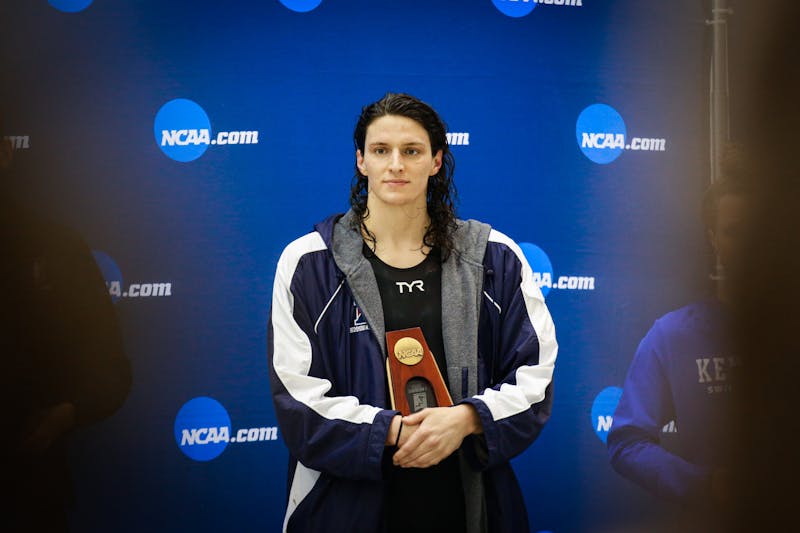I almost fell for it.
I almost bought the idea that the women's magazine Marie Claire wanted young women to feel positively about their bodies. That by including in their June issue an 18 page body image special of bathing suit clad women sizes 0-20, they were saying that size was irrelevant.
Yeah, right. Supermodel Gisele was decked out in lingerie in the first ad and June covergirl Angelina Jolie didn't seem to be an out of the ordinary choice. Even the size zero looked rather grotesque in comparison to the airbrushed and leggy girls that dominated the magazine.
So I put Marie down and picked up an old favorite, Seventeen. My faith was strengthened as I read the cover promotion "127 bathing suits for every body type." But not before I caught the equally loud and neon promotion, "how Britney got that body."
Not even Ladies Home Journal did the trick. The eight blonde four-year olds and cooking tips shown on the cover had fooled me. Inside I learned about the miracles of dieting, including the Lap-Band that I can have surgically inserted to constrict my stomach and prevent me from eating.
Each magazine had come from the "women's interest and fashion" section at the local Barnes & Noble. Most had the expected model on the cover, but paradoxical allusions to size variety and shape acceptance accompanied a disturbing number of them. Even more ironically, most featured the beach work-out or latest fad diet.
If those magazines are any indicator of social concern, women are preoccupied with body image and can only be confused with so many mixed messages perpetuated by the ads and articles themselves.
The ideals presented in current women's magazines are completely skewed. For example, the average body mass index (or weight with regard to height) for a model is 16.3. A criteria for the eating disorder anorexia nervosa is a body mass index of below 18. But the average American woman has an index of 25, the cutoff point from normal to medically overweight.
Penn Psychology Professor Dr. David Sarwer studies the effects of the media on cosmetic surgery and Body Dysmorphic Disorder, in which individuals mentally magnify physical defects to the extreme. He defined the trend I had noticed as an emaciated body ideal escalating since the late 1970's. The ideal has particularly emphasized muscularity and large breasts within the last five years. Since the ideal is unnatural and can only be achieved through rigorous exercise, dieting, or cosmetic surgery, the magazines promote the means to the end that they depict.
And because the media can no longer get away with potentially harmful propaganda, magazines now shamelessly admit to it.
This month's Vogue went as far as providing scientific data saying that the body image ideals are, for the most part, are impossible to achieve.
Vogue's article concerned a $4 million study by the National Institute of Health testing the genetic ability of 175 people to gain muscle mass. The study concluded that while everyone has the ability to grow muscles, we are nonetheless genetically limited as to how big, how fast, and what types of muscles we can grow.
Why then do we continue to live in a culture where, at least for most women, body obsession is the norm?
Coordinator of Penn's Support Team for Eating Concerns and Counseling And Psychological Services psychologist Dr. Margaret Fichter believes that women's self-esteem and body image are so closely related because, culturally, women have valued their bodies as instruments used to attract husbands and have children.
She also maintains that Penn women are among the highest achieving American women and among those suffering most from the strain to conform to bodily ideals. Penn femmes achieve academically and later in life, in their career, often also maintaining a household and raising children. The result of such high expectations often causes women to feel out of control and "revert to focusing on the one thing they think they can control, which is their body."
According to Fichter, over 60% of students who come to CAPS are somewhat to very concerned about their diet, weight, or level of exercise and 50 to 75 students each year seek interdisciplinary help for an eating disorder at CAPS and Student Health.
A member of Penn's educational student group, Guidance for Understanding Image, Diet, and Exercise, Sara Rabold, shared Fichter's view on Penn women. "A lot of people at our campus push themselves; otherwise they wouldn't be at an Ivy League school -- [they're] perfectionists, highly intelligent people. And to be honest with you, those are the type of people who usually have body image issues," said the Wharton junior.
As part of GUIDE, Rabold believes that the answer is education. She hates fashion magazines and so, doesn't read them.
I've tossed mine, and frankly, it feels pretty good.
The Daily Pennsylvanian is an independent, student-run newspaper. Please consider making a donation to support the coverage that shapes the University. Your generosity ensures a future of strong journalism at Penn.
DonatePlease note All comments are eligible for publication in The Daily Pennsylvanian.







